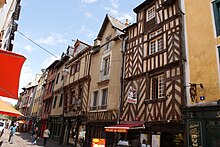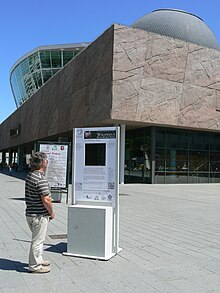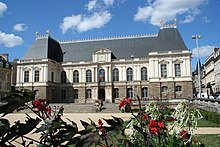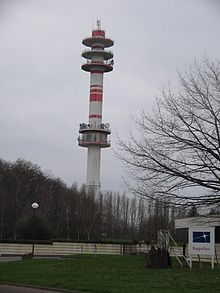Rennes
|
Rennes Roazhon |
||
|---|---|---|

|
|
|
| region | Brittany ( chef-lieu ) | |
| Department | Ille-et-Vilaine ( Prefecture ) | |
| Arrondissement | Rennes ( chef-lieu ) | |
| Canton | Rennes-1 , Rennes-2 , Rennes-3 , Rennes-4 , Rennes-5 , Rennes-6 | |
| Community association | Rennes metropolis | |
| Coordinates | 48 ° 7 ′ N , 1 ° 41 ′ W | |
| height | 20-74 m | |
| surface | 50.39 km 2 | |
| Residents | 216,815 (January 1, 2017) | |
| Population density | 4,303 inhabitants / km 2 | |
| Post Code | 35000, 35200 and 35700 | |
| INSEE code | 35238 | |
| Website | metropole.rennes.fr | |
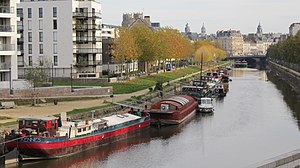 The Vilaine in Rennes |
||
Rennes [ ʀɛn ] ( ) ( Breton : Roazhon , Gallo : Resnn , Latin : Condate ) is the capital of the French region of Brittany and the prefectural seat of the Ille-et-Vilaine department . With a population of 216,815 people (as of January 1, 2017), Rennes is the eleventh largest city in France and the largest in the Brittany region. The Unité urbaine has 335,092 inhabitants, its Aire urbaine 733,320 inhabitants, the tenth largest in France (as of 2017). The large number of students (over 68,000) determines everyday life in the city.
The inhabitants are called Rennais and Rennaises .
geography
location
Rennes is located in western France, around 308 kilometers as the crow flies from the capital Paris . The city is located in the east of the Brittany region, close to the neighboring region of Pays de la Loire .
The Ille flows from the north in the center of Rennes in the Vilaine , flows through the Rennes first from east to west, pivots on the southwestern edge of its territory to the south and at Arzal on the south coast of Brittany in the Atlantic flows. The Canal d'Ille-et-Rance connects in Rennes with the previously navigable Vilaine and connects the city with Saint-Malo on the English Channel .
In Rennes, 28 parks cover a total of 860 hectares and 17% of the municipal area is green.
climate
Rennes has an oceanic climate with low temperature fluctuations between the times of the day and the seasons. Compared to the coastal regions, especially West Brittany, the maritime influence is already slightly weakened. Rennes has around 300 hours of sunshine more than Brest and has daily maximum temperatures of around 3 degrees higher in summer than the port city of Saint-Malo , just 70 km to the north , where autumn and winter are on average much milder than in the capital of Brittany.
| Rennes | ||||||||||||||||||||||||||||||||||||||||||||||||
|---|---|---|---|---|---|---|---|---|---|---|---|---|---|---|---|---|---|---|---|---|---|---|---|---|---|---|---|---|---|---|---|---|---|---|---|---|---|---|---|---|---|---|---|---|---|---|---|---|
| Climate diagram | ||||||||||||||||||||||||||||||||||||||||||||||||
| ||||||||||||||||||||||||||||||||||||||||||||||||
|
Average monthly temperatures and rainfall for Rennes
Source: wetterkontor.de
|
||||||||||||||||||||||||||||||||||||||||||||||||||||||||||||||||||||||||||||||||||||||||||||||||||||||||||||||||||||||||||||||||||||||||||||||||||||||||||||||||||||||||||||||||||||
history
Early and Middle Ages
Rennes was known in the Roman Empire under the name Condate ("confluence", after the location), the Celts called the place Resnn . Condate was the main town of the Civitas Redonum, the area of the Redoner . An inscription has been preserved in Rennes which names a Duumvirn Titus Flavius Postuminus, that is, probably from the time of the Flavians. The increasing threat from invaders led to the construction of a city fortification in 275, and the city also gained importance as a bishopric. After the British were besieged in England by the Anglo-Saxons from the middle of the 5th century, some British emigrated to the area in northwestern Gaul, previously known as Aremorica. Clovis I , the founder of the Franconian Empire , succeeded in 497 in establishing an, albeit loose, suzerainty of the Merovingians over the immigrants called "Bretons". Charlemagne then established the Breton Mark in the east of the Duchy of Brittany , which included the counties of Rennes , Vannes and Nantes . Charles moved against Brittany itself in 786 and 799 without incorporating it into his empire. In the year 851 Nominoë was able to seize the city and the county of Rennes and hold them against the West Frankish King Charles the Bald , who tried in vain to conquer them. While Nominoë's successors were repeatedly in dispute with the Counts of Nantes, the Loire-Normans intervened in these disputes since around 875 , especially since they had a base in Noirmoutier off the Breton coast. Around 880 Duke Judicaël was killed in the battle of Questembert against Alain I , who was Count of Nantes and had allied himself with the Normans; through this victory, Alain gained control of Brittany. After his death in 907 there were again attempts at Norman conquest, and in 937 Alain II became Duke of Brittany. In 952 the Seine-Normans then regained control of Brittany, which, however, regained its independence in 990 under Conan I , who was also able to repel an attack by the Count of Anjou and who, as the only of the Breton dukes, was a mint independent of France in Rennes asserted. His dynasty was followed by the Cornouaille dynasty with Hoël I , also residing in Rennes, from 1066 ; his son Alain IV. was the last Breton-speaking Duke of Brittany and a participant in the 1st Crusade. It was followed by Conan III. , after his death in 1148 there were succession disputes, which his grandson Conan IV was able to win in 1156. However, in the meantime Brittany had become a powerful rival in 1154 in the Angevin Empire of Henry II .
His son Gottfried married Conan's heir, Konstanze , so that the Plantagenets became dukes of Brittany. Gottfried's successor Arthur got into the conflict between the French King Philip II August and the English King Johann Ohneland (Arthur's uncle), in the course of which the pro-French Arthur was killed in 1203. As a confiscated fiefdom, Brittany came under the sovereignty of France, whose king installed the House of Thouars and, a little later, the House of Dreux. With Johann III. the dynasty died out in 1341. Between the heirs Karl von Blois and Johann von Montfort there was then from 1341 to 1364 the Breton War of Succession , from which the city of Rennes also suffered, a dispute that can be seen in connection with the simultaneous Hundred Years War , since Johann was considered the candidate of the English and Karl was the candidate of the French. The Montforts eventually prevailed and rule Rennes for the next century and a half. These are pursuing an increasingly pro-French policy, especially after the English were driven from the continent. The last Breton duke, Franz II (1458–1488), however, once again emphasized Breton independence, set up a separate parliament as a court of justice for Brittany as its symbol in Rennes and approached the Habsburgs, but could not prevent that the French king and his military leader La Tremouille attacked his residence in Rennes after his death and finally forced the marriage of the heir daughter Anne to King Charles VIII , making him heir to the duchy and subjecting it to the French crown in 1491. The area was officially united with France by King Francis I in 1532 .
Modern times
Rennes subsequently prospered thanks to the growing overseas trade, cloth production and agriculture in the area. Under Louis XIV , however, the burdens rose sharply and the tax exemption on salt previously granted to the Bretons was lifted; in 1675 there was also an uprising against the paper tax in Rennes , which was bloodily suppressed. In 1720 a fire ravaged large parts of the city. Today's large squares owe their shape to the reconstruction after the disaster under the direction of the architect Joseph Abeille . In 1789 there was initially clear sympathy for the revolution, but when it turned against the church, resistance was shown by the traditional population (the Chouans ), which was suppressed by the central government in Paris. In order to prevent future aspirations for independence, Brittany was then divided into five departments, Rennes became the seat of the Ille-et-Vilaine department.
In 1857 the city received a railway connection . The review process in the Dreyfus affair took place here in 1899 .
In the 20th century, Breton nationalism experienced a renewal. It showed itself in cultural initiatives, such as the revival of the Breton language , but also in violent actions. In Rennes, for example, a memorial commemorating the Bretons' oath of loyalty to France was blown up. The attempt of the German invaders, however, to use this movement for their own purposes in the Second World War, failed; Bretons, like the French, took part in the fight against the occupying power, which withdrew from Rennes in 1944. After the war, efforts were made to promote the long neglected region, so an automobile factory was built in Rennes. As a symbol of the cultural independence of the Bretons, the street signs have been bilingual since 1985, even though French is still the official language and Breton is less common in the east of Brittany around Rennes than in the west. The traditional language of the Rennes region is rather the Gallo , a Gallo-Roman dialect. The headlines were finally made by the fire in the old parliament building in Rennes in 1994.
Population development
| year | 1962 | 1968 | 1975 | 1982 | 1990 | 1999 | 2011 | 2017 |
| Residents | 151.948 | 180.943 | 198,305 | 194,656 | 197,536 | 206.229 | 208.033 | 216,815 |
| Sources: Cassini and INSEE | ||||||||
science and education
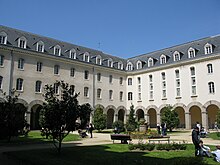
Rennes has two universities, but other universities also operate a campus in Rennes:
- CentraleSupélec , a grande école
- École supérieure d'électricité : electricity
- École pour l'informatique et les techniques avancées : Computer science
- Rennes University 1 : Natural Sciences (Biology, Chemistry, Physics, Mathematics, Geology) Medicine and Philosophy
- Rennes University 2 : humanities, languages, literature
- Paris School of Business : Administration
- Sciences Po Rennes : Politics and Economy
Rennes is also the seat of the ESC Rennes School of Business , which is one of the world's best business schools .
There are also several “Ecoles nationales” in Rennes, for example the ENSCR (Ecole Nationale Supérieure de Chimie de Rennes) and the “Conservatoire de Region de Rennes”, which trains in music, dance and theater. The large number of students (around 63,000, the eighth largest city in France) determines everyday life in the city. At the same time, numerous festivals (such as the music festival Les Transmusicales , Les tombées de la nuit , Mythos and Rock and Solex , the country's first student festival) take place, which are known beyond the borders of France.
Culture
Rennes has an opera house, is the seat of the Théâtre National de Bretagne and the "Center choréographique national de Rennes et de Bretagne" as well as the "Orchester de Bretagne". There is also an art museum that shows pictures from practically every era. Diverse cultural institutions in the individual districts complete the cultural offer.
Attractions
See also: List of Monuments historiques in Rennes
Rennes has a whole range of sights from all eras of the city's history:
At the Place des Lices:
- Les Halles Martenot (19th century) by Jean-Baptiste Martenot (1828–1906)
- Porte Mordelaise (or Portes Mordelaises, 15th century), a small city palace with two towers and a drawbridge
- Tour Duchesne (15th century)
- Remains of the old city wall (3rd century)
- 15th century fortifications
At Place St. Anne:
- Saint-Aubin church
- Old hospice (14th century)
- Jacobin Convent
On rue Saint-Melaine:
- Benedictine monastery of Saint-Melaine with Notre-Dame-en-Saint-Melaine church
- Jardin du Thabor (French garden with orangery, rose garden and aviary)
On the rue Saint-Georges
- Palais Saint-Georges with park
At the Place de la Mairie (Plasenn Ti Ker):
South of the Vilaine:
- Musée des Beaux-Arts (Museum of Fine Arts)
- Les Champs Libres: Brittany museum, library and science center
houses of Parliament
The " Parlement " is located in the center of the city. It was built in the early 1618-1655 by the architect Salomon de Brosse . The construction was financed with the help of the royal wine tax. It was the highest place of royal justice in the province of Brittany. In 1675 the parliament (the judges) were sent to Vannes after the "paper-timbré" uprising to satisfy the claims there. The city of Rennes lost power and became economically weak. The Comtesse de Sévigné declared: “Without Parliament, Rennes is no more valuable than Vitré ”. The officers returned in 1690 on royal orders.
In 1720 a fire ravaged the whole city. Fortunately, only part of the parliament roof was damaged. When the forecourt was redesigned as “Place de Louis le Grand” in 1726 by Jacques V Gabriel (father of Ange-Jacques Gabriel ), the south facade of the building was redesigned; the terrace and the flight of stairs were omitted. A bronze equestrian statue of Louis XIV was placed on the square. The redesign to "Place Royale" made it clear that Parliament was a royal place of power. In 1994 the parliament building burned down, was severely damaged and rebuilt in ten years. The parliament is still the highest court in the region.
traffic
The transport connections are good, with a motorway-like ring road the city is easy to reach by car.

The station Rennes , which also TGV is operated trains on, can be reached in two hours from Paris. The TGV Atlantique runs from Paris to the Finistère cities of Quimper and Brest. There are also several local train lines that connect Rennes with, among others, Vitré , Nantes (via Messac-Guipry), Châteaubriant , Montreuil-sur-Ille , Saint-Brieuc and Dinan / Saint-Malo . With the LGV Bretagne-Pays de la Loire , which is scheduled to go into operation in summer 2017, the TGV to Paris will only need 1 hour 30 minutes.
The public transport system is a well-developed bus system and a fully automated metro carried out since 2002 in operation. In November 2007, the decision was made to expand the first and build a second subway line. The preparatory work for the expansion of the underground and a new line has started and should be completed by 2020. Rennes will then have around 30 km of underground line. Since March 2006 it has been possible, unusual for France, to use trains and local public transport with a single ticket (“KorriGo”).
Rennes Airport is located southwest of the city . Today the waterways are only of touristic importance. They include the Vilaine , which is navigable from Rennes to its mouth on the south coast of Brittany, and the Canal d'Ille-et-Rance , which runs from Rennes to the north coast of Brittany and flows into the English Channel at Saint-Malo .
Industry
In addition to the production of PSA vehicles (models Citroën C5 and Peugeot 508 I ) - the plant, which was inaugurated in 1961, is located in the suburb of Chartres de Bretagne, right next to the Saint-Jacques-de-la-Lande airport - the telecommunications sector provides the most important economic branch of the city. Rennes is the main editorial office of Ouest-France , the newspaper with the highest circulation in France.
mayor
The mayoress Nathalie Appéré ( PS ) has been in office since 2014 . Her predecessors were Daniel Delaveau (2008–2014, PS), Edmond Hervé (1977–2008, PS), Henri Fréville (1953–1977, MRP ) and Yves Milon (1945–1947, 1947–1953, RPF ).
Other facilities
The Thourie transmitter is located near the district of Thourie .
Town twinning
-
 Erlangen , Germany , since 1964
Erlangen , Germany , since 1964 -
 Exeter , UK , since 1957
Exeter , UK , since 1957 -
 Rochester , United States , since 1958
Rochester , United States , since 1958 -
 Brno , Czech Republic , since 1965
Brno , Czech Republic , since 1965 -
 Sendai , Japan , since 1967
Sendai , Japan , since 1967 -
 Leuven (Leuven), Belgium , since 1980
Leuven (Leuven), Belgium , since 1980 -
 Cork , Ireland , since 1982
Cork , Ireland , since 1982 -
 Sétif , Algeria , since 1982
Sétif , Algeria , since 1982 -
 Jinan , Shandong , People's Republic of China , since 1985 (Shandong Province has a partnership with the Brittany region)
Jinan , Shandong , People's Republic of China , since 1985 (Shandong Province has a partnership with the Brittany region) -
 Almaty , Kazakhstan , since 1991
Almaty , Kazakhstan , since 1991 -
 Poznań , Poland , since 1998
Poznań , Poland , since 1998 -
 Hermannstadt (Sibiu), Romania , since 1999
Hermannstadt (Sibiu), Romania , since 1999
Personalities
A to J
- Soazig Aaron (* 1949), writer
- Camille Abily (* 1984), soccer player
- Suzanne Bastid (1906–1995), lawyer
- Jean Baptiste Bédard (1765–1815), violinist, harpist, guitarist and composer
- Patrick Bertron (* 1962), cook
- Eugène Bigot (1888–1965), composer and conductor
- Jacques Philippe Marie Binet (1786-1856), mathematician
- Jean-de-Dieu-Raymond de Boisgelin de Cucé (1732–1804), cardinal and member of the Académie française
- Georges Boulanger (1837-1891), General
- Yves Boutet (* 1936), football player
- Marcel Bozzuffi (1928–1988), film actor
- Stéphane Brizé (* 1966), actor, director and screenwriter
- Godefroy Brossay-Saint-Marc (1803–1878), (Arch) Bishop of Rennes, Cardinal
- Marcel Callo (1921–1945), Catholic youth worker and opponent of National Socialism
- Louis-René de Caradeuc de La Chalotais (1701–1785), lawyer
- Éric Caravaca (* 1966), actor and film director
- Adélaïde-Marie Champion de Cicé (1749–1818), religious and founder of the Society of the Immaculate Heart of Mary
- Alphonse Chantoux (1920–1998), Prefect Apostolic of Fada N'Gourma
- Alphonse de Châteaubriant (1877–1951), writer and collaborator
- Yves Cochet (* 1946), politician (Europe Écologie-Les Verts)
- Maxime Daniel (* 1991), road cyclist
- Anatole Deibler (1863–1939), executioner
- Laurent Delamontagne (born 1965), football player
- Léger Marie Deschamps (1716–1774), utopian and philosopher
- Alfred Ditte (1843–1908), chemist
- Théodore Le Du (1893–1966), racing car driver
- Alexandre-Vincent Pineux Duval , called Alexandre Duval (1767–1842), architect, writer and theater director
- Martial Fesselier (* 1961), sports enthusiast
- Paul Féval (1816-1887), writer (Sir Francis Trolopp)
- Armindo Fonseca (* 1989), racing cyclist
- Julien Louis Geoffroy (1743-1814), dramatic critic
- Philippe Ghis (1882–1918), football player, athlete and co-founder of the Stade Rennes club
- Marc Gomez (* 1954), racing cyclist
- Simon Goubert (* 1960), jazz drummer, pianist, arranger and composer
- Jenia Grebennikov (* 1990), volleyball player
- René Guillou (1903–1958), composer
- Jean Guisnel (* 1951), journalist and publicist
- Gwennyn (* 1974), songwriter
- Yannick Haenel (* 1967), writer and novelist
- Stéphane Heulot (* 1971), racing cyclist
- Pierick Houdy (* 1929), French-Canadian composer and music teacher
- Adélaïde-Louise-Pauline Hus (1734–1805), actress of the Comédie-Française and courtesan (Mademoiselle Hus)
- Jules Isaac (1877–1963), historian
- Jean-Paul James (* 1952), Archbishop of Bordeaux
- Dom Paul Jausions (1834–1870), Benedictine and pioneer of the restitution of Gregorian chant
- Pascale Jeuland (* 1987), cyclist
- Jean-Yves Jolif , OP (1923–1979), Dominican and translator from ancient Greek
K to Z
- Jean-Claude Kaufmann (* 1948), sociologist
- Auguste Hilarion de Kératry (1769–1859), writer and politician
- Francis Kerbiriou (* 1951), sprinter
- Paul Lagarde (* 1934), legal scholar
- Matthieu Lahaye (* 1984), racing car driver
- Catherine Lalumière (* 1935), politician (PRG)
- Jean-Denis Lanjuinais (1753–1827), politician
- Isaac René Guy Le Chapelier (1754–1794), politician during the French Revolution
- Théodore Le Du (1893–1966), racing car driver
- Michel Ange Bernard de Mangourit (1752–1829), diplomatic agent, ambassador, publicist and writer
- Félix Martin-Feuillée (1830–1898), lawyer and politician
- Briac Menoret (* 1994), football player
- Jean Baptiste Métivier (1781–1853), Franco-German architect and Bavarian construction clerk
- Lucien Musset (1922-2004), historian
- Adolphe Nicolas (1936–2020), geologist and geophysicist
- Louis-Henri Nicot (1878–1944), sculptor
- Charles Oberthür (1845–1924), French entomologist
- Michel Pansard (* 1955), Catholic clergyman, Bishop of Evry-Corbeil-Essonnes
- Toussaint-Guillaume Picquet de la Motte (1720–1791), admiral
- Christophe Pierre (* 1946), Vatican diplomat
- François-Henri Pinault (* 1962), manager
- René Pleven (1901–1993), politician
- Claude Poullart des Places (1679–1709), Roman Catholic clergyman and founder of the Spiritan order
- Joseph Marie Quérard (1797–1865), bibliographer
- Guy-Marie Riobé (1911–1978), Roman Catholic Bishop of Orléans
- Lucie Robert-Diessel (1936–2019), composer and pianist
- Jean-Baptiste-René Robinet (1735–1820), natural philosopher and encyclopaedist
- Pierre-Jean Robiquet (1780-1840), chemist
- Lindsay Rose (* 1992), soccer player
- Hippolyte-Marie de Rosnyvinen (1778–1850), general of the cavalry
- Marie Rouault (1813–1881), geologist, paleontologist and fossil collector
- Laure Sainclair (* 1972), porn actress
- Anna Sam (* 1980), author and blogger
- Yves-Thibault de Silguy (* 1948), politician, businessman and high official
- Julien Simon (* 1985), racing cyclist
- Pierre-Henri Teitgen (1908–1997), lawyer, professor and politician
- Louis Tiercelin (1849-1915), writer
- Joëlle Timsit (* 1938), diplomat
- René-Joseph de Tournemine (1661–1739), Jesuit
- Joseph Turmel (1859–1943), modernist and historian of dogmatics
- Charles Vanel (1892–1989), actor and director
- Aubert de Villaine (* 1939), winemaker
- René Worms (1869–1926), sociologist and philosopher
literature
- François Bertin: Rennes sous l'occupation. Rennes: Ouest-France, 1979
- Le Patrimoine des Communes d'Ille-et-Vilaine. Flohic Editions, Volume 2, Paris 2000, ISBN 2-84234-072-8 , pp. 1211-1300.
Ouest-France , historic seat
Web links
Individual evidence
- ↑ Population légale municipale 2017 ( fr ) INSEE . Retrieved January 3, 2010.
- ↑ Classement des villes étudiantes 2019–2020 ( fr ) L'Etudiant. Retrieved January 3, 2020.
- ↑ Ille-et-Vilaine ( fr ) habitants.fr. Retrieved January 10, 2020.
- ↑ A la découverte des parcs ( fr ) Rennes and Rennes Métropole commune. Retrieved January 10, 2020.
- ^ Financial Times Ranking
- ↑ Regional Atlas


